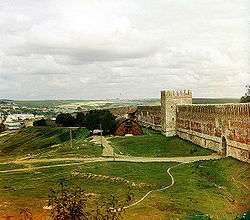Smolensk Kremlin

Smolensk Kremlin (Russian: Смоленский кремль) is a kremlin (a fortress) enclosing the center of the city of Smolensk in western Russia. The partially preserved fortress wall was built between 1595 and 1602, during the reign of Tsars Fyodor I Ioannovich and Boris Godunov. The length of the walls is about 6.5 kilometres (4.0 mi), of which less than the half was preserved. The fortifications were built under supervision of the architect Fyodor Kon. The Smolensk Kremlin is classified as an architectural monument protected at the federal level,[1] and also has a great historical significance, in particular, as the fortress protecting the Russian state from the west over centuries.
History
Smolensk historically had a great significance for the defence, and this is why Russian rulers paid considerable attention for its fortifications. In the spring of 1554, Tsar Ivan the Terrible ordered to build a new tall wooden fortress. After the development of artillery, it became clear that a wooden fortress was no longer suitable for the defence, and in the end of the 16th century it was decided to build a new stone fortress at the place of the old one.
In December 1595, the preparations for the construction started after the official decree was issued. The construction works were very intense and were performed daily from sunrise to sunset. The construction workers, however, lived in harsh conditions, and revolted in 1599 because of hunger, cold, and diseases. In the summer of 1597 long and heavy rains flooded all the trenches and ditches, and the construction workers had to strengthen the landslide soil by piles. In 1600, because of the heat and heavy rains, a large amount of crops was lost in Russia, causing the famine.
The construction of the new fortress used the old existing fortifications, so that in some places the wall was built on top of them, and in certain areas the new fortress was extended beyond the limits set by the old one. . The construction started from the western side of the fortress.
Towers and walls


Several sections of the wall survived, the eastern section with nine towers, the south-western section with five towers, and the northern section with three towers.
The history of an ancient city is inseparably linked with legends which give special charm to its antique monuments. One of these legends says that Boris Godunov arrived to the laying of the Smolensk’s Stone Kremlin’s foundations and put a terrible curse on it. Since then, anyone who attacked the Kremlin came to a terrible fate.
If we believe to the rumors, from time to time from the walls of the Kremlin could be heard a horses laugh. Based on the legend, during the construction of the Kremlin, the death’s head of the battle horse of St. Mercury, who is the protector of the city was buried inside the walls. He was the fighting man who rescued the city in the 13th century from the Mongol army. Every time the horse laughs, it lets everyone know beforehand about the dangerous curse.
The most famous remaining tower is the round-cornered tower named Veselukha. This name was given to it because of the nice view which opens from the tower. In the daytime, citizens lead their guests to see the beautiful suburbs. However, in the evening time and especially during the night it is a rather dangerous place and has a bad reputation. Brave hearts who dare to appear at this place told about horror phantoms and ghosts. Finally it was found the reasonable explanation to that awful fact. This place was used by the counterfeiters who printed out false money and scared people who tried to walk around.
The Main Gate Tower was Frolovskaya (Dnieper Tower), through which was the exit to the capital of the Russian state. The second most important was Molohovskaya tower, opens the way to Kiev, Krasny and Roslavl.
The surviving towers are
- Pyatnitskaya (Water Tower)
- Volkova
- Kostyrevskaya (Red Tower)
- Veselukha (Luchinskaya)
- Pozdnyakova (Rogovka)
- Oryol (Gorogetskaya)
- Avraamievskaya
- Zaaltarnaya (Belukha)
- Voronina
- Dolgochevskaya
- Zimbulka
- Nikolskaya
- Mokhovaya
- Donets
- Gromovaya
- Bubleika
- Kopytenskaya
References
- ↑ Крепостные стены и башни (Крепость Смоленская) (in Russian). Russian Ministry of Culture. Retrieved 5 August 2011.
External links
| Wikimedia Commons has media related to Smolensk Kremlin. |
- Fortifications of Smolensk (Russian)
Coordinates: 54°47′11″N 32°03′56″E / 54.78639°N 32.06556°E